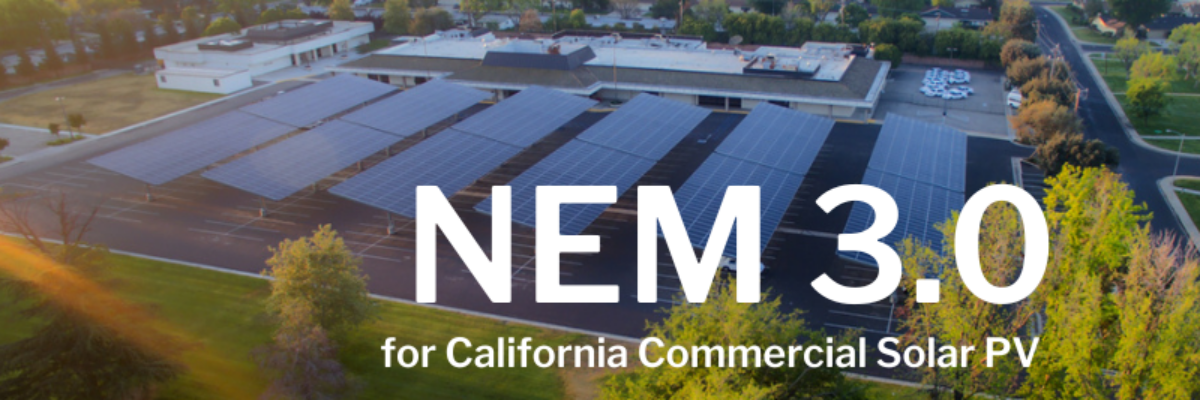How the New Net Billing Tariff (NBT) Affects Virtual Net Metering
The Net Energy Metering Aggregation (NEMA) and Virtual Net Metering (VNEM) tariffs are currently being evaluated by the California Public Utilities Commission (CPUC) to determine how – or if – these tariffs will be supported after NEM 2.0 tariff was closed. Thus far, the CPUC’s proposed solutions would effectively or completely eliminate NEMA and VNEM. Renewable energy advocates are pushing back.
Background
The CPUC made a final decision in the NEM 3.0 proceeding on December 15, 2022. That decision eliminated net energy metering as of April 15, 2023, for the three main investor-owned utilities in CA – PG&E, SCE, and SDG&E – and replaced net energy metering with a Net Billing Tariff (NBT). The NBT allows an electricity customer to generate and consume electricity on their property and be credited with the full retail value of that locally generated and consumed electricity. For example, if you install a solar photovoltaic (PV) system and it reduces the amount of electricity you are consuming at that time, then your electric bill is reduced by that amount of electricity, typically 20-30 cents per kilowatt hour. However, if you produce more electricity than you consume at any time, the value of the exported energy is credited at a small fraction of the retail energy price, approximately 5 cents per kilowatt hour. This very low price for exported energy incentivizes customers to not export energy to the utility electrical grid by either putting in smaller solar PV systems or storing some of the solar generated energy in batteries. The NBT is already having a major impact on solar PV installation in California.
Since customers using the NEMA and VNEM tariffs rely on exporting electricity to have it virtually applied to other electrical meters, these tariffs would no longer provide necessary financial benefits to NEMA/VNEM customers if the exported electricity has such a low value. Many NEMA customers are public agencies such as schools, while many VNEM customers are renters in multifamily buildings that have no opportunity to install solar and often can’t afford it.
The CPUC was aware that NBT would render the NEMA and VNEM tariffs useless, so they expressly left them out of the December 15 ruling, electing to address this issue in a separate future process. That process is now underway, and the proposals put forward by the CPUC do not adequately address the loss of value caused by the change to the NBT.
How NEMA and VNEM are Affected
NEMA and VNEM work by allowing customers to install and connect solar and battery systems to one meter and then share that energy across multiple other meters on the building/property and adjacent parcels. This allows customers to build a solar PV system in the most efficient location that produces enough electricity to offset usage from multiple customer meters. Excess energy produced on the meter where the solar PV system is connected is credited to the other meters in the NEMA/VNEM arrangement. This is particularly important for schools and multifamily housing where viable sites for solar PV systems are limited and where there are multiple electric meters. This will also be increasingly important for electric vehicle (EV) charging loads, as utilities are now implementing EV-specific tariffs that require separate metering.
The key to the NEMA and VNEM tariffs is that excess electricity generated on one meter is exported to the utility distribution system and credited at the full retail electricity rate to the other local electric meters in the arrangement. However, if exported energy is valued at 5 cents per kilowatt hour per the NBT, the economics of NEMA and VNEM arrangements would not be viable, rendering these tariffs useless.
The table below shows the estimated impact of low NBT export rates on a hypothetical school with four electric meters in a NEMA arrangement.
Annual Value of Solar with Existing NEMA and NBT Export for a Public School
| Meter | Electricity Usage, kWh | Electricity Cost, $/kWh | Electricity Cost Before Solar | Solar PV Production kWh | Electricity Exported kWh | NEMA Value of Energy, Current Tariff | NEMA Value of Energy, NBT Export |
|---|---|---|---|---|---|---|---|
| 1 | 200,000 | $0.24 | $48,000 | 490,000 | 290,000 | $43,000 | $43,000 |
| 2 | 100,000 | $0.26 | $26,000 | 0 | 0 | $23,000 | $3,000 |
| 3 | 75,000 | $0.25 | $19,000 | 0 | 0 | $17,000 | $2,000 |
| 4 | 170,000 | $0.22 | $37,000 | 0 | 0 | $34,000 | $4,000 |
| Totals | 545,000 | $130,000 | 490,000 | 290,000 | $117,000 | $52,000 |
The table above shows that the value of solar energy in a NEMA arrangement using NBT export values is less than 45% of the value of solar under the current NEMA tariff. To put this in perspective, even with new solar PV incentives available to schools under the Inflation Reduction Act, a typical school solar project today takes 12-14 years to break even. If the value of solar is reduced to 45%, the payback period jumps to 27-31 years. This is longer than the anticipated lifetime of the solar PV system, rendering the investment unviable.
What You Can Do
The CPUC is currently in the process of making changes to the NEMA and VNEM tariffs to bring them in line with the final decision and NBT export energy values. Interested parties are providing input and your voice is critical. The California Solar and Storage Association (CalSSA) has a sign-on letter that states the case. Below is a link that takes you to the letter and a simple sign-on form. We encourage you to read the letter and add your school to the list of signatories.
Don’t hesitate to reach out to NV5’s Clean Energy group with questions.
NV5 Clean Energy
(415) 663-9914
https://staging.nv5.com/about-nv5/contact-us/

